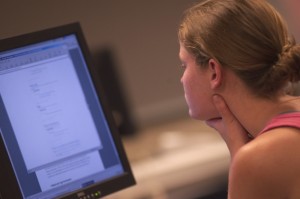
Scotland and the Netherlands both invest significantly more federal money per student in information and communications technologies (ICT) than the United States, and they both view ICT as essential to classroom teaching and learning and in developing 21st-century skills, a delegation of education technology advocates discovered during a recent visit to the two countries.
The results of that visit, led by the Consortium for School Networking (CoSN), appear in a report issued May 12, called “Real Investment, Real Innovation.”
“Scotland and the Netherlands approach ICT in the classroom as an absolute necessity—not as a luxury—for improving learning and teaching, as well as developing workforce skills,” the report noted. “We found this attitude inspirational, particularly in view of the continuing debate in the U.S. about the unproven and uncertain value of technology.”
The delegation aimed to gauge how well-prepared students in Scotland and the Netherlands are for success in a global economy, explore innovative uses of education technology, discover some common challenges in using ICT in education, and identify unique policies and practices in Scotland and the Netherlands that might be replicated in the United States.
“Across the globe, technology is being leveraged to enhance learning and boost administrative efficiency in schools,” said Keith Krueger, CoSN’s CEO. “U.S. educators and policy makers need to look at best practices from around the world if they hope to use technology to transform learning and enable the enterprise of education.”
According to the report, after taking into account the unusually high U.S. federal investment in education technology that came in the form of $650 million through the American Recovery and Reinvestment Act (ARRA), the U.S. spent “$922 million on classroom technology to support nearly 50 million students” in 2009.
And while exact comparisons between the U.S. and European countries are difficult owing to differences in government and programs, the most recent budget for BECTA—the U.K. government agency advocating for effective education technology use—was $161 million in U.S. dollars for a student population of 8 million. In the Netherlands, the Ministry of Education spent $27.7 million last year to operate Kennisnet, the organization that focuses on supporting ICT implementation in K-12 schools for 2.5 million students.
Excluding ARRA funding and looking at the most recent annual ed-tech appropriations of $272 million, the U.S. has spent $5.44 in U.S. dollars per student on ICT at the federal level, compared with $10.80 in the Netherlands and $20.10 in the U.K.
“Replicating the policies and approaches that exist in Scotland and the Netherlands will be difficult, given that the system of local control is a powerful cornerstone of American public education,” the report acknowledged.
Still, it said the U.S. could learn from the existence of a strong policy framework, a clear vision, and strategic investments in ICT within the two European countries.
“At the federal level, leadership at the U.S. Department of Education and the White House can play a critical role in … creating the sense of urgency that will inspire local leaders to interpret and adapt ICT,” the report said.
The report likened the two countries’ commitment to ICT, and the strong policy framework that accompanies that commitment, to the potential that the recently released National Education Technology Plan holds for education in the United States.
“This kind of vision and commitment of resources to ICT has been largely absent at the national level in the U.S. given the structure of American education, with most technology planning and acquisition decisions driven by state agencies and local district administrators,” the report said. “We are hopeful that the National Education Technology Plan may provide some of the missing vision for U.S. educators and policy makers.”
Unique resources
The CoSN-led delegation, which included educators, policy makers, and leaders from national education associations, found many innovative approaches to solving technology and engagement problems during its visit abroad. One school in the Netherlands has a “laptop doctor” who helps teachers and students when hardware stops working properly. A teacher in Scotland incorporated students’ Nintendo Gameboys into a mathematics lesson.
Scotland’s ICT investment takes shape in Glow, which is often termed “the world’s first national intranet for education.” The safe, free online environment gives students, teachers, and parents space to create and share resources.
Glow Groups allow classes to complete class work and homework online, work with other classes in different schools, and even work with pupils across the world on collaborative online projects. All school systems in Scotland voluntarily have signed on to participate in Glow, which is funded and managed by the Scottish government and delivered by RM, a private company.
“The ‘a-ha’ moment for me was in Scotland and the excellent implementation of Glow in two different settings with both kindergarten students and with middle school-age students,” said Lois Adams-Rodgers, deputy executive director of the Council of Chief State School Officers.
Aided by government funding, the Netherlands has created a nonprofit partnership, called Kennisnet, that offers all educational facilities independent advice and services for safe and effective technology use.
Three examples stood out when the delegation visited the Netherlands, and all three involved collaboratively produced, teacher-created digital repositories.
The DigilessesnVO.nl project uses a cooperative group of schools that pay for the chance to contribute to and share in a learning object repository. Teachers produce classroom lessons and make those lessons available to other teachers within the group, and each school must produce at least 10 lessons or learning objects annually. Schools pay 2,300 Euros per school, per year (roughly $3,000 U.S. dollars) to participate, and at the time of the report’s publication, 30 schools had signed on to participate. Teachers send their lessons to editors, who tweak the assignments and enter them into the repository.
The delegation noted that the U.S. has similar initiatives, such as OER Commons and Curriki—but the DigilessenVO.nl is unique in its mix of school collaboration, a cooperative business model, and a minimal threshold for participation.
Digischool, which started 10 years ago, is an online teacher network with more than 200,000 teachers throughout the Netherlands. The network is organized according to subject area and grade level. “Community organizers” spur the activity in this network, in addition to maintaining their full-time teaching position, and they receive a small stipend for their efforts.
The Learning Resource Exchange (LRE), launched by European Schoolnet, lets schools find educational content from different countries and providers. LRE currently offers more than 130,000 learning resources and assets.
This year, Kennisnet is rolling out Wikiwijs, an open, internet-based platform where teachers can find, use, and develop open learning materials. The partnership also is developing initiatives around digital identity and social networking.
“Throughout our discussions with leaders at Kennisnet, they reminded us that we cannot ignore Web 2.0 trends and student usage of Web 2.0 tools, but must embrace and shape them for learning,” the delegation reported. “Contrast this with the typical situation in the U.S., where we block and ban access to social networking sites rather than promote and adapt [them] for learning.”
“We saw amazing uses of technology in classrooms and very traditional uses of technology. Traditional and technology seems like an oxymoron,” said Andrea Prejean, senior policy analyst for the National Education Association. “There was individualized instruction facilitated by technology, the integration of students’ interests into their learning, and a teacher [who] was so excited by her students that she was nearly bouncing with excitement.”
The CoSN delegation hopes to continue its collaboration with Scotland and the Netherlands and explore how the countries’ policies might be integrated or replicated in the United States. It also will publicize its findings to a broad range of constituencies.
The Pearson Foundation, SMART Technologies, netTrekker, and RM Education sponsored the delegation’s trip.
The delegation said that focusing on technology as a necessity “could help everyone recognize that technology is no longer an ‘add-on’ to the curriculum or an optional luxury, but essential to educating tomorrow’s leaders.”
Links:
Report from Scotland and the Netherlands: Real Investment, Real Innovation
Consortium for School Networking
- A look at AI use in schools across the country - November 18, 2024
- 5 ways your classroom environment boosts student engagement - November 14, 2024
- Federal toolkit targets safe, ethical AI use in classrooms - November 11, 2024


